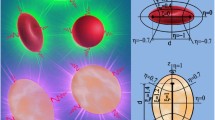Abstract
Optoacoustic (OA) spectral properties of various sources mimicking normal and pathological red blood cells (RBCs) have been studied. The shapes of normal RBC and cells suffering from stomatocytosis (denoted by ST) were generated using mathematical models. However, the shape corresponding to the cells affected by echinocytosis (referred to as ET) was constructed by uniformly distributing half prolate spheroids on a central spherical object. The OA field emitted by an acoustically inhomogeneous source was calculated for a wide acoustic frequency bandwidth (1–1500 MHz with an increment 5 MHz) by solving the time-independent wave equation employing a modified Green’s function approach. The OA spectra averaged over 200 orientations for normal RBC and STs demonstrate similar features (one minimum occurring nearly at 906 MHz). The same graphs for ETs are remarkably different from that of normal RBC and exhibit better match with that of a spherical RBC (first minimum appearing at around 425 MHz). The spectral features of ETs above 425 MHz may enable us to differentiate diseased cells (echinocytosis) from normal RBCs.







Similar content being viewed by others
References
Bessis Marcel (1973) Red cell shapes. An illustrated classification and its rationale. Springer, Berlin, pp 1–25
Chu Dezhang, Ye Zhen (1999) A phase-compensated distorted wave born approximation representation of the bistatic scattering by weakly scattering objects: Application to zooplankton. J Acoust Soc Am 106(4):1732–1743
Da Costa Lydie, Galimand Julie, Fenneteau Odile, Mohandas Narla (2013) Hereditary spherocytosis, elliptocytosis, and other red cell membrane disorders. Blood Rev 27(4):167–178
Das Dhiman, Sharma Arunima, Rajendran Praveenbalaji, Pramanik Manojit (2021) Another decade of photoacoustic imaging. Phy Med Biol 66:05TR01
Diebold GJ, Sun T, Khan MI (1991) Photoacoustic monopole radiation in one, two, and three dimensions. Phys Rev Lett 67(24):3384
Galanzha Ekaterina I, Zharov Vladimir P (2013) Circulating tumor cell detection and capture by photoacoustic flow cytometry in vivo and ex vivo. Cancers 5(4):1691–1738
Gerald Lim HW, Wortis Michael, Mukhopadhyay Ranjan (2002) Stomatocyte-discocyte-echinocyte sequence of the human red blood cell: evidence for the bilayer-couple hypothesis from membrane mechanics. Proc Natl Acad Sci 99(26):16766–16769
He Li LuLu, Li Xuejin, Buffet Pierre A, Dao Ming, Karniadakis George E, Suresh Subra (2018) Mechanics of diseased red blood cells in human spleen and consequences for hereditary blood disorders. Proc Natl Acad Sci 115(38):9574–9579
https://www.cmu.edu/biolphys/deserno/pdf/sphere_equi.pdfhttps://www.cmu.edu/biolphys/deserno/pdf/sphere_equi.pdf
Ishimaru Akira (2002) Wave propagation and scattering in random media. Wiley, New York
Juratli Mazen A, Menyaev Yulian A, Sarimollaoglu Mustafa, Siegel Eric R, Nedosekin Dmitry A, Suen James Y, Melerzanov Alexander V, Juratli Tareq A, Galanzha Ekaterina I, Zharov Vladimir P (2016) Real-time label-free embolus detection using in vivo photoacoustic flow cytometry. PLoS One 11(5):e0156269
Kaushik Anuj, Saha Ratan K (2021) Characterization of normal and deformed red blood cells using simulated differential photoacoustic cross-section spectral data. J Phys Commun 5:035007
Kaushik Anuj, Sonker Deepak, Saha Ratan K (2019) Study on angular distribution of differential photoacoustic cross-section and its implication in source size determination. J Opt Soc of Am A 36(3):387–396
Kaushik Anuj, Paul Avijit, Saha Ratan K (2020) Systematic analysis of frequency dependent differential photoacoustic cross-section data for source size estimation. J Opt Soc Am A 37(12):1895–1904
Kaushik Anuj, Yalavarthy Phaneendra K, Saha Ratan K (2020) onvergent born series improves the accuracy of numerical solution of time-independent photoacoustic wave equation. J Modern Opt 67(9):849–855
Larkin Timothy J, Kuchel Philip W (2010) Mathematical models of naturally morphed human erythrocytes: stomatocytes and echinocytes. Bull Math Biol 72(6):1323–1333
Morse Philip M, Feshbach Herman (1953) Methods of theoretical physics. McGraw-Hill, New York
Morse Philip M, Uno Ingard K (1968) Theoretical acoustics. McGraw-Hill, New York
Muñoz San Martín S, Sebastián JL, Sancho M, Álvarez G (2006) Modeling normal and altered human erythrocyte shapes by a new parametric equation: application to the calculation of induced transmembrane potentials. Bioelectromagnetics 27(7):521–527
Neukammer Jörg, Gohlke Carsten, Höpe Andreas, Wessel Thomas, Rinneberg Herbert (2003) Angular distribution of light scattered by single biological cells and oriented particle agglomerates. Appl Op 42(31):6388–6397
Ranjan Mukhopadhyay HW, Lim Gerald, Wortis Michael (2002) Echinocyte shapes: bending, stretching, and shear determine spicule shape and spacing. Biophysical J 82(4):1756–1772
Saha Ratan K (2020) Numerical solution to the time-independent inhomogeneous photoacoustic wave equation using the born series methods. J Opt Soc Am A 37(12):1907–1915
Saha Ratan K (2021) Solving time-independent inhomogeneous optoacoustic wave equation numerically with a modified green’s function approach. J Acoust Soc Am 149(6):4039–4048
Saha Ratan K, Kolios Michael C (2011) A simulation study on photoacoustic signals from red blood cells. J Acoust Soc Am 129(5):2935–2943
Saha Ratan K, Karmakar Subhajit, Adhikari Arunabha, Kolios Michael C (2017) Photoacoustic field calculation for nonspherical axisymmetric fluid particles. Biomed Phys Eng Express 3(1):015017
Schiff Leonard I (1969) Quantum mechanics. McGraw-Hill Education, Asia
Sharma Subodh K, Saha Ratan K (2009) A new approximate formula for scattering of plane acoustic waves by a spherical obstacle. Acta Acust United Acust 95(1):1–6
Strohm Eric M, Berndl Elizabeth SL, Kolios Michael C (2013a) Probing red blood cell morphology using high-frequency photoacoustics. Biophysical J 105(1):59–67
Strohm Eric M, Berndl Elizabeth SL, Kolios Michael C (2013b) High frequency label-free photoacoustic microscopy of single cells. Photoacoustics 1(3–4):49–53
Wang Lihong V (2017) Photoacoustic imaging and spectroscopy. CRC Press, Boca Raton
Wang Lihong V, Yao Junjie (2016) A practical guide to photoacoustic tomography in the life sciences. Nat Methods 13(8):627
Acknowledgements
The author would like to thank ICMR (# 56/2/2020-Hae/BMS) for providing financial support to carry out this work.
Author information
Authors and Affiliations
Corresponding author
Additional information
Publisher's Note
Springer Nature remains neutral with regard to jurisdictional claims in published maps and institutional affiliations.
Rights and permissions
About this article
Cite this article
Saha, R.K. Predicting optoacoustic spectral behaviour of human erythrocytes, stomatocytes and echinocytes using a modified Green’s function method. Eur Biophys J 51, 67–76 (2022). https://doi.org/10.1007/s00249-021-01579-5
Received:
Revised:
Accepted:
Published:
Issue Date:
DOI: https://doi.org/10.1007/s00249-021-01579-5




